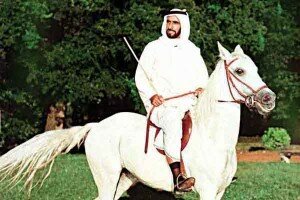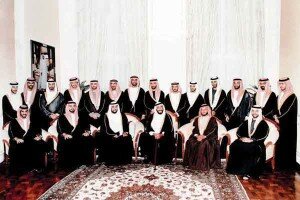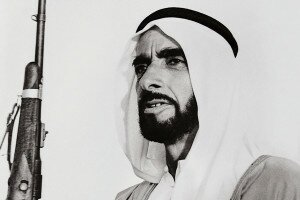Sheikh Zayed bin Sultan Al Nahyan is revered by his people. But in his role as a leader of the state it can be easy to overlook his personal qualities. What kind of man was he?
“He was handsome, with humorous and intelligent eyes, of fine presence and bearing, simply dressed, and clearly a man of action and resolution.”
Edward Henderson was a British diplomat who became an Arabian Gulf specialist. During his many years in the Gulf, Henderson befriended almost every ruler there; but he was especially close to Sheikh Zayed.
“Although he was young, and had only been formally in charge of the [Al Ain/Al Buraimi] oasis and its surrounding deserts for some two years, he was experienced in the politics of the region, and was already by far the most prominent personality in the area.”
In his 1988 autobiography ‘This Strange Eventful History’, Henderson says he was generally impressed by Zayed’s political astuteness, and commented that “He had a sure touch with the Bedouin”.
“He had a strong, intelligent face, with steady, observant eyes, and his manner was quiet but masterful.”
The British adventurer Wilfred Thesiger met the young Sheikh Zayed for the first time in 1948. His travels, documented in ‘Arabian Sands’, had taken him to Al Ain, where Sheikh Zayed was the ruler’s representative. The two men formed a long- lasting friendship.
Part of Zayed’s strength was his natural skill as a negotiator and diplomat: “Zayed as the leader of a large family always sits to listen to people’s problems and then find the right solution, sorting out the disputes, with satisfaction for all in a manner characterised by intelligence, wisdom and justice.“
Like Henderson, Thesiger noted his easy way with the Bedouin: “They liked him for his easy, informal ways and his friendliness, and they respected his force of character, his shrewdness and his physical strength.
“They said admiringly ‘Zayed is a Bedu. He knows about camels, can ride like one of us, can shoot, and knows how to fight’.”
“I was amazed by many of the crowd that has always been massing around him in the Buraimi Oasis, surrounded by respect and attention.”
Hugh Boustead, who succeeded Henderson as the British political representative in Abu Dhabi, is another who noted how Zayed commanded respect.
In his 1971 memoirs ‘The Wind of Morning’ Boustead also confirmed Zayed’s understanding of the value of infrastructure – something that the ruler later brought to the leadership of his country and the development of Abu Dhabi’s cities. “He was very generous with his money and I was amazed by all the work done in his hometown of Al Ain and in the entire region for the benefit of the people. The construction of canals to increase the water supply to irrigate orchards and digging wells.”
“Sheikh Zayed was viewed as a quiet, capable negotiator. It was a role in which he was adept.”
That was the view of former French president Valery Giscard d’Estaing. After he became Ruler of Abu Dhabi and President of the UAE, Sheikh Zayed had more occasion to mix with his peers on the international stage. There was no question of coming second best to them.
Former US president Jimmy Carter recalled: “Sheikh Zayed negotiated quietly and without any publicity… He never sought credit or approval for his diplomatic efforts. Yet he was tireless, even in the face of belligerence and bad faith among those that he was trying to help.”
Another former French president, Jacques Chirac, observed tellingly that “Sheikh Zayed lived and ruled over such a span of time that he held within him an extraordinary knowledge, an encyclopaedia knowledge of modern world events and history. And he was often the one making that history.”
“Sheikh Zayed felt that here we are one people.”
Zaki Nusseibeh, the long-serving translator and interpreter for Sheikh Zayed, had a real insight into the leader’s motivations, which he shared in an interview in Bidoun magazine.
“He was… a unionist from the outset, and he was a pan-Arabist as well – he wanted the entire Arab world to come together and work together in closer cooperation. But in the Emirates, yes, he felt that all the people belonged to the same community, shared the same history, the same traditions, the same heritage.
“He felt that this was a country that already had a past, and that it could coalesce around an idea. The idea was that we could have our own future, we will build our own community.”
And here’s Zayed the pragmatist: “Sheikh Zayed had to start somewhere. When he started building the state, he had nobody around him. He brought in anyone he thought could help. This is why he welcomed people from all countries, Arab or non-Arab.
“But at the same time, he said from the outset that our real resource is our people, and therefore we must focus on education. From the beginning he said that the first priority for the government should be to build schools and to bring the boys and girls into schools.
“He made education compulsory for every boy and every girl. We must take the schools, he said, to out where the Bedu live, so that they can accustom themselves to living in an urban environment, even in these traditional areas, so that their children will go to school…”
“He was one of the few great men I have met, and if we did not always agree, the reason for our disagreement was my ignorance.”
Captain Anthony Shepherd was an officer with the Trucial Oman Scouts troop in Al Ain. His book ‘Arabian Adventure’ described Sheikh Zayed as “undoubtedly the most powerful figure in the Trucial States” [the forerunner of the UAE].
“I used to visit him weekly in his fort, and he would always describe the local political situation to me in an excellent manner. I always came to him with great respect and I left him with even greater respect.”























